TikTok UGC: How Brands Use TikTok User-Generated Content (Guide)
From boosting organic reach to scaling Spark Ads, brands are all-in on TikTok UGC. We dig into the benefits of TikTok using user-generated content...
Which types of TikTok ads are best for your brand? Get to know the different TikTok ad formats and which is the best for nailing your paid campaign goals.
/types%20of%20tiktok%20ads%202000x1000.jpeg)
As we explore the TikTok ad types below, brainstorm how you can potentially weave your influencer content and UGC into your campaigns. Some formats make doing so easier than others. Creators should be a cornerstone of your TikTok ad strategy regardless.
And with that, let's dive into the TikTok ad types and examples!
TikTok Spark Ads resemble videos from creators you'd seen on your #FYP. With Spark Ads, brands turn organic videos into sponsored content.
These videos allow brands to piggyback on their creators' audiences for better targeting and greater reach. Spark Ads are presented from the account of the creator rather than the brand. These details boost Spark Ads' performance because at a glance they don't feel like ads at all.
Here's a Spark Ad example to highlight what we're talking about. Note the ad's high engagement rate and the fact that it resembles a creator video. That's the point!
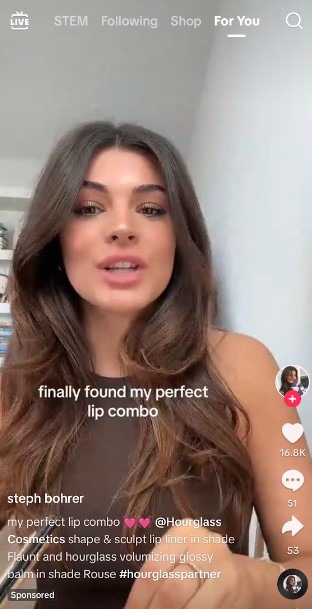
The Spark format is also unique among all types of TikTok ads because of the "sparking" process. Turning organic videos into TikTok ads requires creators to exchange a unique ad authorization code with brands.
While brands cannot edit videos they run as Spark Ads, this isn't necessarily a negative. No edits ensure authenticity and eliminate the need to "optimize" ad creatives by hand.
We've seen firsthand how creators improve ad performance for brands on TikTok. For example, Viori has collaborated with over 2,000 creators on TikTok using Statusphere to boost the performance of the brand's ad campaigns. Check out their case study for the full story and results!
A relatively new TikTok ad type, Search ads are delivered when they hit the search button on the FYP.
How do they work? When brands turn on the Search Ads toggle, ads are automatically created from the advertiser's existing content and get served similarly to organic content in search results.
These ads are delivered like other in-feed TikTok ads across various positions. The transition from search results to a promoted video feels natural.
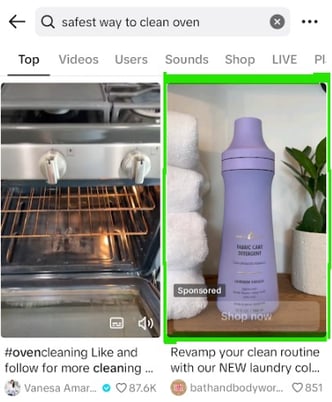
The difference is that these ads have a “sponsored” label. Using TikTok’s algorithms, they’ll match with users based on relevancy, user intent (derived from the search term), and user behavior.
Note that the Search Ad toggle is automatically activated when a brand sets up an in-feed ad campaign but can be toggled off at any time.
However, it generally makes sense to leave it on. This new type of ad has proven to be highly effective with 70% of ad groups seeing more efficient performance when compared to not. Makes sense given the popularity of TikTok SEO among the platform's t target audience.
TikTok Shopping ads are shoppable videos that appear as TikTokers scroll through their #FYP or search results. Users browse TikTok Shopping ads by tapping a product anchor link or product card.
Note that you can use your call-to-action via Video Shopping Ads to send shoppers to TikTok Shop or an external product page beyond TikTok (see below).
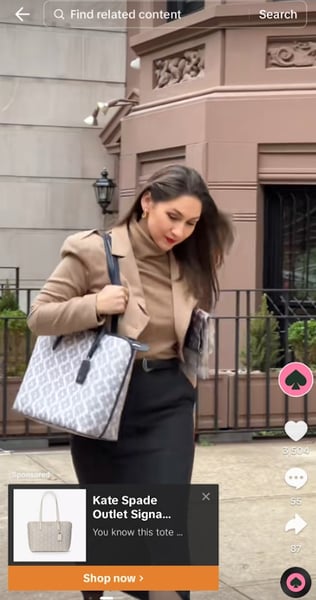
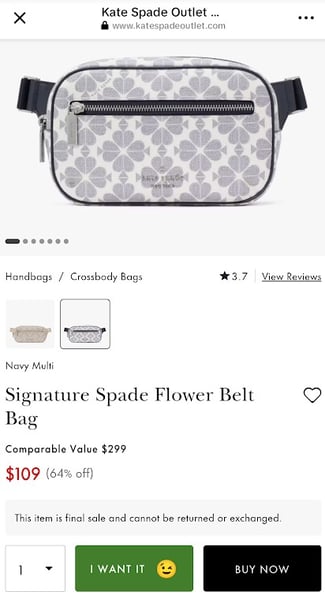
Brands can use advanced targeting based on demographics, interests, video interactions and other behaviors to uncover audiences most likely to buy from TikTok.
Shoppers can purchase anywhere from four to 20 products directly from these promotions. This gives brands creative freedom to present multiple offers in the same video to maximize engagement. Especially if you're running TikTok Shop ads featuring a variety of creators.
No surprises here! TikTokers will see these ads as they scroll through their "For You" feed.
In-Feed ads can be short and sweet, with videos between 9 to 15 seconds seeming to be the “sweet spot" in terms of performance. TikTokers can actually engage with these ads via likes, comments (sometimes) and shares as they would non-ads. Note that these ads are also skippable.
Check out how this Peter Thomas Roth in-feed ad feels like something you might see organically on your FYP. Keep in mind that this is different from a Spark Ad because it presents from the brand's @handle and not the creator's.
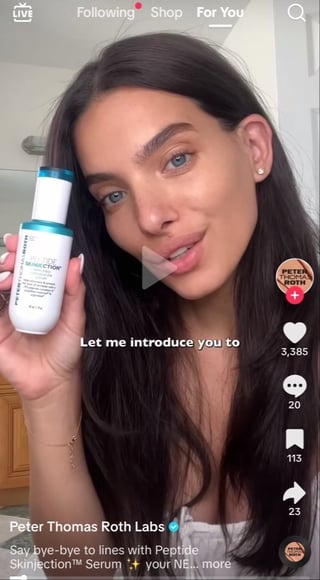
Source: @peterthomasrothofficial
Brands that create these types of TikTok video ads can include captions, images, and a call-to-action button that all link to an external landing page. If your goal is to funnel sales from TikTok to your website, In-Feed ads can do the trick.
Important: Collection Ads are being phased out as a standalone TikTok ad format. Brands can still access them as a category of Video Shopping Ads under the "Product Sales" objective.
Collection Ads allow shoppers to engage with a full-screen gallery feed consisting of a collection of products. Brands can choose their highlighted products or let TikTok Ad Manager pull them from their Shop based on relevance.
Beyond interactivity, a notable superpower of these types of TikTok ads is their speed.
These ads deliver a seamless shopping experience with a succinct selection of products that are easy to browse via images. Shoppers are taken to the brand's website to complete their purchase.
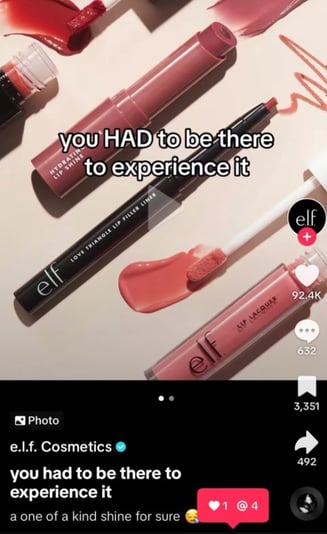
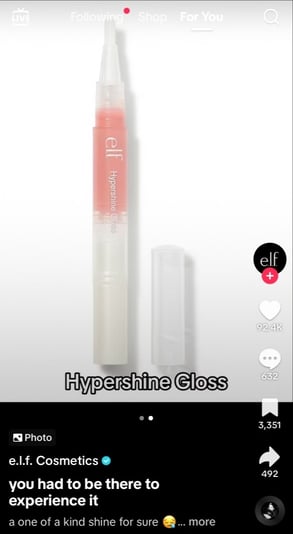
Delivered in-feed, Carousel ads are images that contain up to 35 (!!!) product shots for TikTok shoppers to swipe through at their own pace.
These types of TikTok Ads come in two flavors: VSA (Video Shopping Ads) or Standard. VSA is ideal for driving sales while Standard is designed for goals related to traffic and awareness. The VSA version can feature between 2 and 20 product images. Standard can show between 2 and 35.
As you’d imagine, VSA has clickable links to the website that are unique for each product and the standard has just one CTA for all — or a swipe left that leads to the landing page. Both always include music plus ad captions and a CTA for all images.
This example from the Gap shows a clean and easy way for TikTokers to scroll through a mix of options.
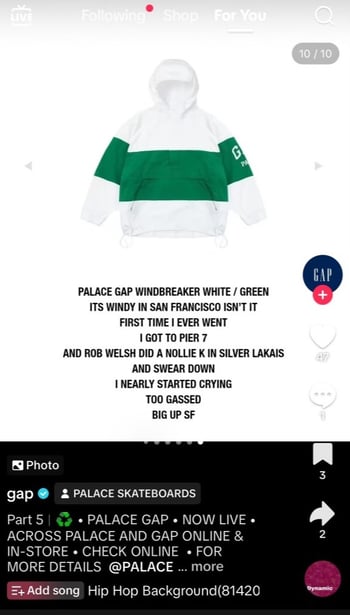
TikTok has experimented with a wide variety of ad formats since its inception. Some formats have undergone significant changes while others have been sunsetted completely.
The types of TikTok ads we discussed above are ideal for brands that work with creators with an emphasis on shopping and awareness. These formats are fair game for brands of all shapes and sizes.
That said, some TikTok ad formats are more akin to "traditional" commercials and big budget productions. We'll break down a few of those below!
These “video-first format” ads are 60 seconds long and appear immediately after someone opens the TikTok app.
TopView Ads are unique because they’re full-screen and auto-play with sound. Advertisers can include a call-to-action button within the ad.
And these ads are quite literally “must-see” since they take over your entire screen.
If you’re looking for seamless ads that feel organic, TopView ads probably aren’t your best bet. That’s because they can potentially interrupt the user experience. Coupled with their length, TopView are among the most “traditional” of TikTok’s video ads because they feel like commercials.
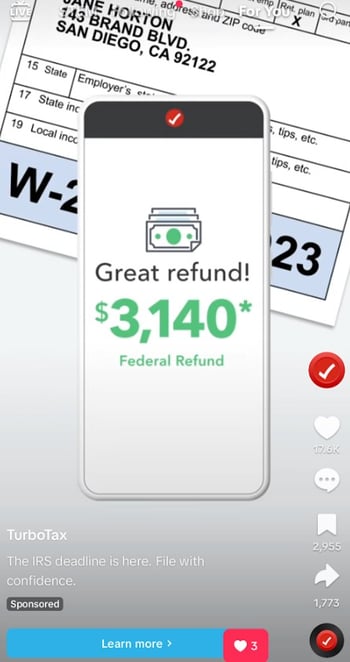
However, that doesn’t stop them from being effective. 71% of TikTokers say TopView ads grab their attention. The platform also notes that CPG companies experienced 67% higher sales effectiveness when using these types of TikTok ads. Go figure!
These full-screen ads appear on the FYP immediately after someone opens TikTok. They’re created using 3 to 5-second videos (or 3-second images), directing viewers to a Hashtag Challenge or landing page. Brands can choose either depending on their campaign objective.
TikTokers only see one Branded Takeover ad per day. This means less competition for the ad space but also makes them a bit pricey.
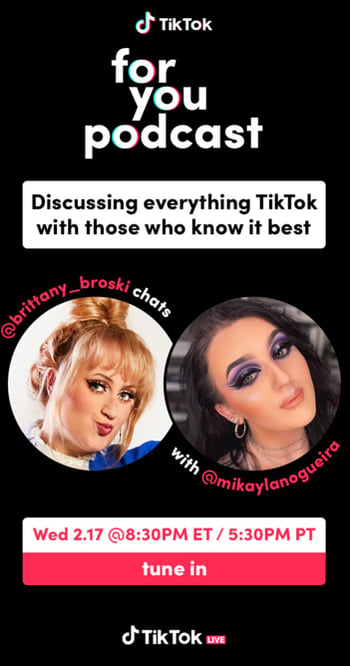
Source: TikTok
These sponsored hashtag challenges are featured on a hashtag results page or the Explore banner.
Here’s a snapshot of how these types of TikTok ads work:
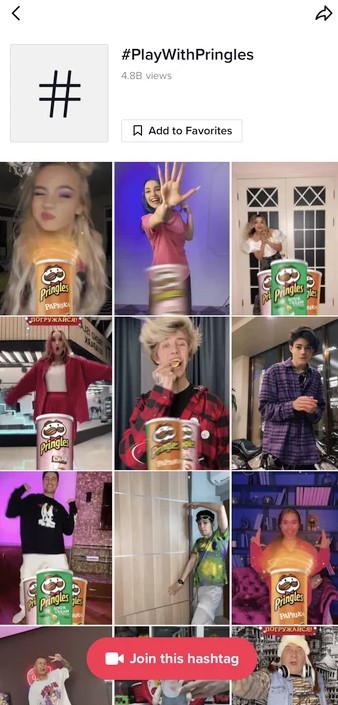
The #PlayWithPringles challenge is an awesome example of how powerful Branded Hashtag Challenge Ads can be. This particular challenge launched in Germany, France and Italy during the pandemic. Participants showed off their creativity through dance, comedy and TikTok’s music library.
To say the campaign was a success would be an understatement. Nearly 350,000 TikTokers contributed to the challenge which earned over one billion views at the time!
Think Snapchat and Instagram! Just like with these platforms, Branded Effects allow brands to create sharable stickers, filters and special effects on TikTok for self-promotion. Brands will often combine this format with other TikTok ads.
The benefit? Filters and special effects are often loud and flashy, making them perfect for TikTok’s audience. These types of ads are ideal for drumming up engagement and likewise getting more UGC.
For example, PUMA created a Branded Effect (along with a hashtag challenge) to promote their Future Flash collection under the #FlashOfFuture tag. This campaign garnered 587.5 million views at the time.
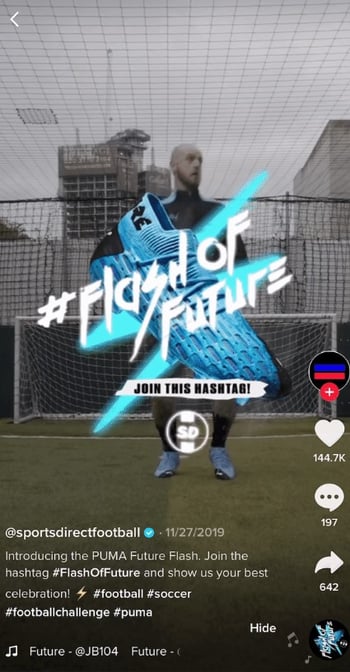
Let’s say you’re brainstorming ideas for your own TikTok campaigns.
Nice! But what kind of TikTok ad types do you want to create? What should your vibe be?
To wrap things up, let’s look at some creative ideas and inspiration to help you understand the TikTok ad types that really resonate with viewers.
Fact: 39% of TikTok users say “lifting spirits” is a key factor in deciding whether to purchase a product. Anything you can do to empower, inspire or make life easier for your audience is a plus. For example, check out how Noom motivates viewers on their weight loss journies and shares authentic stories that really tap into what TikTok is all about.
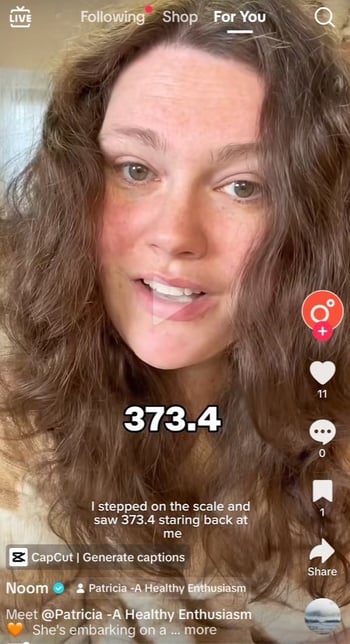
Source: @noom
Humor is a big part of the platform. Maybe that's why TikTok ads with comedy cues are 24% more likely to be watched all the way through. Incorporating humor into your ads is a perfect way to keep them from feeling like ads at all.
Brands like Duluth Trading Company have mastered the art of making ads that show off products but begin with a comedic hook to reel in viewers.
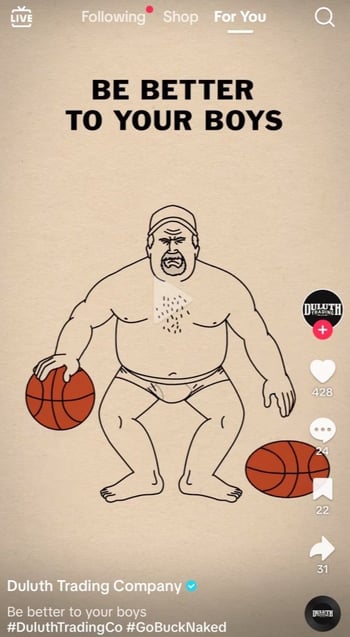
Source: @duluthtradingcompany
Remember what we said earlier about the effectiveness of creator-based ads?
Well, we’re saying it again! TikTok ads that feel like organic content tend to perform well. On that note, TikTok ads featuring creators achieved 91% higher two-second view rates versus non-creator ads (8%). Check out this TikTok promotional post for Starface that really popped off.
These are the types of posts that fit seamlessly into your audience’s feeds and don’t feel salesy. At the same time, you’re able to show off your products more as viewers stick around longer to learn more.
While these posts aren’t exactly a TikTok ad type, your brand can still partner with creators to hit your advertising goals.
And given that TikTok influencers already know how to create quality content for their highly engaged audience, they’re a brilliant starting point for advertising on TikTok.
You don’t have to look hard to find brands promoting products on TikTok.
Whether you’re looking to expand to TikTok or reach an existing audience, running an ad campaign can boost engagement sooner rather than later.
The good news? Depending on your goals and budget, chances are there’s a TikTok ad type that makes perfect sense for your business.
That said, we’ve seen firsthand how creator campaigns (and creator-based ads) totally crush it when it comes to performance. This rings true for brands of all shapes and sizes.
If you want to earn more authentic TikTok content to fuel your ad campaigns, Statusphere can help.
Our micro-influencer marketing platform helps brands earn authentic content at scale with the help of our advanced matchmaking and our vetted creator community.

Unlike other platforms, we can guarantee a specific volume of content for our brands on TikTok. Not to mention features like Instant Spark Ads to streamline turning your influencers' content into ads.
The end result is hundreds (or thousands!) of pieces of content versus just a handful. That means you're spoiled for choice in terms of which content you run as TikTok ads. We've already generated 75,000+ posts on behalf of 400+ consumer brands.
Want to see how our software works? Get in touch with one of our campaign experts to see how we can optimize your TikTok ad strategy with guaranteed content at scale.
This article was first published in March 2021. It was last updated March 23, 2025.
From boosting organic reach to scaling Spark Ads, brands are all-in on TikTok UGC. We dig into the benefits of TikTok using user-generated content...
What do the best TikTok Spark Ads have in common? Below we share seven Spark Ad examples highlighting how TikTok UGC translates into awesome brand...
Is advertising on TikTok worth it? Fair question! Below we dig into the proven pros, potential cons and everything else brands should know about...